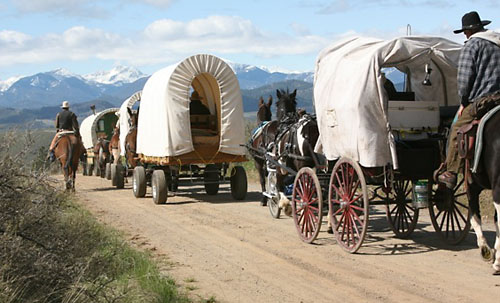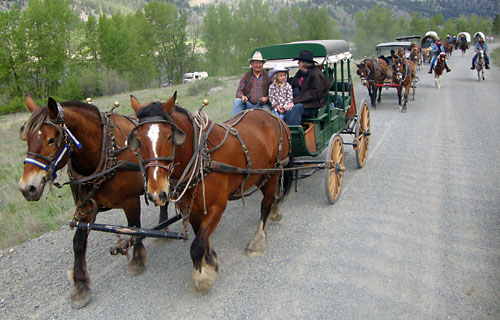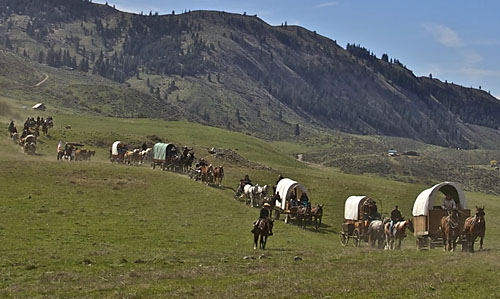home | internet service | web design | business directory | bulletin board | advertise | events calendar | contact | weather | cams

 Wagons ho. Outriders accompany three wagons with modern day inflatable tires and one with traditional wooden wheels, as they make their way along a valley road. Photo by Kit Cramer Wagons ho. Outriders accompany three wagons with modern day inflatable tires and one with traditional wooden wheels, as they make their way along a valley road. Photo by Kit CramerLeather, Weather, Sweat & Fun This year is a triple-anniversary year for the Washington Outfitters and Guides Association (WOGA), which is why the Methow Valley’s horse and packing history is getting special emphasis at the upcoming ’49er Days celebration. WOGA, started by Winthrop’s Claude Miller and five other packers, including Tom Graves and the late Ole Scott, is celebrating its 40th birthday. This year also marks the 25th anniversary of WOGA’s participation in ’49er Days, and the 15th year of the WOGA-sponsored Ride to Rendezvous. WOGA was organized because the Forest Service started requiring packers to carry insurance before permits would be issued to take hunters and other guests into the backcountry, Miller said recently. “We could negotiate with the Forest Service a little better if we were organized.” He traveled to Idaho and Montana, which already had strong organizations representing backcountry guides, and later went to Washington, D.C., to represent the packers’ views at a meeting with a powerful senator. Miller also helped organize the National Outfitters Association.  Claude Miller, who helped found the Washington Outfitters and Guides Association and its annual Ride to Rendezvous, drives a handsome team. His passengers are Jadyn Mitchell and her grandmother, Marva Mountjoy. All three are participating in the 2013 ride. Photo by Bruce Carpenter Claude Miller, who helped found the Washington Outfitters and Guides Association and its annual Ride to Rendezvous, drives a handsome team. His passengers are Jadyn Mitchell and her grandmother, Marva Mountjoy. All three are participating in the 2013 ride. Photo by Bruce CarpenterTom Graves credits WOGA’s participation in the ’49ers Day parade and the outfitters’ encampment in the park with revitalizing the annual festival 25 years ago. The outfitters had tried to get a rendezvous started in Leavenworth, he explained, but they were turned down, so they came to Winthrop, which was a better fit anyway. “If it hadn’t been for the outfitters, [‘49er Days] would have died out,” Graves said. WOGA’s Ride to Rendezvous started in 1999 and by its 10th anniversary there were 300 paying participants, according to Marva Mountjoy, WOGA office manager, who worked for Miller for years. The ride now is limited to 100 guests to assure a quality experience. And while it is WOGA’s largest annual fundraiser, the hope is that it gives a taste of the backcountry that leads to at least some participants signing on for trips with individual WOGA members. The ride also has meant that dozens of local kids and adults have gotten experience working on the support crew over the years. Miller laughs remembering the early days when he put on a ride himself. “I tried to make myself some money earlier in the season,” he said. It was 1972, the year the North Cascade Highway opened. Three women, including one who had been on a pack trip with him earlier, signed up for his four-day adventure.  The Ride to Rendezvous wagon train makes its way cross-country on an earlier ride with the grand sweep of the hills for a backdrop. Photo by Bruce Carpenter The Ride to Rendezvous wagon train makes its way cross-country on an earlier ride with the grand sweep of the hills for a backdrop. Photo by Bruce Carpenter“It rained so god-damned hard for two or three days you couldn’t see,” he said. The wagons got mired in mud. A buddy saw things were going south and fetched his motor home so they could at least be inside to cook. The women toughed it out and slept in tents. To try to make the best of it, Miller said he told stories. Actually, he didn’t say that. What he said was: “I bullshitted them the whole way.” And on the fourth day, the sky cleared and the sunflowers popped out. “It was so pretty,” he recalled. Later, a group called Women in the Wilderness, started by packer Debby Willem over on the Teanaway, put on very successful rides, Miller said. Willem also founded Camp Wahoo, a horse camp for kids. At some point, Miller said a challenge was issued to get a ride organized in the Methow. Thus Ride to Rendezvous got started 15 years ago. Miller said he told WOGA, “I’ll head this up, but the first time somebody tells me how to do it, I’ll give it to ’em.” He continues to help plan the route and share local history whether or not the riders are interested. And, of course, he provides horses and wagons and drives a team himself. It’s a natural fit for a man who spent a lot of years maintaining one of the largest herds of broke-to-ride horses in the West and packing guests and hunters into the hills. “I get along with horses and I love the mountains,” he said. 5/6/2013 Comments
|